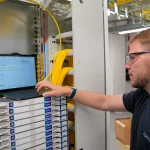Government May Open UK Utilities Infrastructure for Broadband

The UK government (DCMS) will today launch a call for evidence as part of a new review of the Access to Infrastructure (ATI) Regulations 2016, which could enable “gigabit-capable” broadband operators to expand their networks by harnessing existing electricity, gas, water and sewer networks via infrastructure sharing.
The idea is intended to support the Government’s planned public investment of £5bn (here), which aims to help spread “gigabit-capable” broadband networks to every home across the United Kingdom by the end of 2025 (funding for this will go toward the final 20% of premises in harder to reach locations, such as rural areas); this remains an incredibly difficult target to actually hit.
In theory gigabit providers could boost this deployment via more infrastructure sharing. Indeed it’s claimed in today’s announcement that more than 1 million kilometres of underground utility ducts could potentially play a role in the upgrade.
Advertisement
The call for evidence also highlights the possibility of opening up “access for broadband network operators to house their equipment on ‘passive’ infrastructure owned and used by other telecoms companies. Passive infrastructure includes utility ducts, poles, masts, pipes, inspection chambers, manholes, cabinets, and antenna installations.” That’ll be a “fun” industry engagement exercise (more on this later).
Finally, there’s a mention of making it easier for broadband operators to “run cables along new and existing infrastructure lining the road and rail networks,” which already happens a fair bit as part of limited commercial agreements. But such things can run into problems when significant disruption, safety or a risk of damage occurs (e.g. National Rail is sensitive to such work on river bridges and any potential delays to the train service).
In other words, telecoms companies are already free to make their own commercial agreements on infrastructure sharing, but meanwhile the ATI Regulations 2016 “have not been widely used.” The ATI includes provisions on the exchange of information about existing infrastructure, and the right to access that infrastructure on fair and reasonable commercial terms etc.
Matt Warman, UK Minister for Digital Infrastructure, said:
“It makes both economic and common sense for firms rolling out gigabit broadband to make use of the infrastructure that already exists across the country. This will help them avoid the high costs and disruption of having to dig or build their own and ultimately benefit consumers.
We’ve seen progress with improved access to Openreach’s ducts and poles, but other telecoms companies have large networks that are not easily accessible. We want them, and utility companies, to do more to open these up and help speed up getting next-generation broadband to people across the UK.”
Clare MacNamara, CEO of the Broadband Stakeholder Group, said:
“It is important for the Broadband Stakeholder Group that the right measures are in place to support UK fibre and gigabit rollout in order for industry to meet the target of nationwide availability by 2025. We therefore welcome Government’s review of the regulations.”
On the surface infrastructure sharing often seems like “economic and common sense“, but the reality can be complex. In order to understand this it’s often helpful to look at some of the challenges involved. For example, running fibre optic cable down water and sewer networks doesn’t always work due to limited space, access and the fact that a lot of these things are too old or unstable to risk such disruption. On the flip side it’s possible to use such fibre deployments to help monitor water supplies in real-time.
Advertisement
Similarly making use of existing electricity networks might seem like a no-brainer (or gas mains), but once again there are good reasons why such an approach is not widely used. One of the main issues is safety. Dealing with high powered electricity cables or gas requires a different set of skills, considerations and knowledge, as well as greater precautions (you can’t just ask ordinary fibre engineers to do it). Likewise coordinating electrical and telecoms work can be tricky, which can in turn add delays and thus costs.
The new call recognises some of the aforementioned caveats and notes that “large amounts of the sewer and gas network are unsuitable for building communications networks.” Ofcom has previously investigated the possibility of deploying full fibre networks across combinations of different non-telecoms infrastructure and found that the duplication of engineering efforts and maintenance costs could be unattractive.
Next we come to the issue of infrastructure sharing between telecoms operators. The fact that it took quite a few years for Openreach’s (BT) existing Physical Infrastructure Access (PIA) product, which gives rival ISPs access to run their own fibre through the operator’s cable ducts, to reach the point it’s at today is one example of how difficult such change can be to implement. The same could be said of mobile operators (here).
Extending this sort of idea to the wider market is thus likely to run into problems due to the difficulty of balancing competitive interests between so many rivals in the same space (the ‘herding cats‘ analogy again). Furthermore there can be technical differences between networks and operators tend to consider detailed knowledge of their existing or future infrastructure to be commercially sensitive (confidential) information.
Advertisement
On top of all this there’s the issue of whether such sharing would actually produce the sort of national benefits desired. Certainly there are areas where it may help, but a lot of this will be for improving backhaul (capacity) connectivity rather than reaching individual homes. Backhaul fibre is already quite widely available, although room for improvement does exist.
Despite all of this the potential advantages, such as from reducing street words, costs and improving coverage at a more rapid pace cannot be ignored. The fact that some degree of infrastructure sharing, however difficult to achieve, does already exist (e.g. Openreach’s PIA and the recent agreement between mobile operators – here) also shows that such things are indeed possible and can work.
The catch here is that those two examples above only came about after significant pressure from Ofcom and the Government, which in both cases took years to realise. The same sort of pressure isn’t going to work with newer or smaller entrants in the fibre space (they’re already carrying a lot of risk and rewards in this field take time to materialise), although they are looking at improving access to Virgin Media’s network via the ATI Regs. But more incentives may be needed to encourage greater co-operation.
The Government’s review will now assess if there are any changes that could be made to the ATI regulations in order to further boost investment in infrastructure, and encourage the use of infrastructure sharing to increase the availability of gigabit-capable broadband. The Call for Evidence closes on 4th September 2020.
Call for Evidence – ATI Regulations 2016
https://www.gov.uk/government/publications/review-of-the-access-to-infrastructure-regulations-call-for-evidence
Mark is a professional technology writer, IT consultant and computer engineer from Dorset (England), he also founded ISPreview in 1999 and enjoys analysing the latest telecoms and broadband developments. Find me on X (Twitter), Mastodon, Facebook, BlueSky, Threads.net and Linkedin.
« ISP TalkTalk See Broadband Base Shrink to 4.22m as Fibre Grows
Openreach Finish City-Wide FTTP Broadband Cover of Salisbury »






















































In some other countries I’ve seen cable operators who’ve got their coaxial cables on poles. Can this be done in the UK?
Technically yes. If engineeringly safe for both the cables and the resultant forces on the pole.
If you go to Ho Chi Minh City in Vietnam you can see everything on one pole starting with high voltage at the top, local OH power distribution (including electricity meters), phone, DSL units and yes even what looks like fibre. Hopefully the UK Government are not proposing similar.
We will have to await the scope of the legislation and whether it is just going to be main utility networks or whether it will include all municipal and even private infrastructures. For instance VM duct would be useful to Alnets but very unlikely to be included.
Altnets
Where I live op has put poles up and placed fttp cable on it to negate the need to dig underneath a concrete area on my property, however the engineer’s wouldn’t splice off the cable which would of given me fttp broadband
I remember back in the day in Hong Kong they used to just string CAT5 over rooftops!
It’s a shame Matt warman can’t help his own constituents with help for http broadband, I have a fibre optic cable running down my property border, but in order for me and my neighborhood to get fttp, I have to find nearly £200k to pay for for a fttp network via the community funded project, how is that helping rural communities??
I have to ask where did you get the information that a fibre cable runs down your property?
Anybody remembers Bournemouth’s fibre through sewers debacle?
There was an investigation into what wrong:
Drains up = To establish in detail what has occurred, typically after the failure of a process and/or system.
Fibre To The Toilet? That’s taking the p…!
GNewton, do you have any other information of links for the Bournemouth debacle please?
We wanted to lay our fibre network across a road in a village. We then found out a new build house was getting gas, electric and water from the other side of the road. We aske the three utiility companies if we could share their road cut. None of them would share with us, or each other. There were four cuts across the road, with the road on traffic lights for months. Each dig was done at a different time, with none of them prepared to work together.
chris conder I fear anything so sensible was not enabled in their bureaucratic process. In fact i’d be prepared to learn they all had the
same software. If you asked to be included in their cut no response, i take it that it was as impossible if you asked and offered them,
for some moderate payment well under the known costs, to join you in your cut?